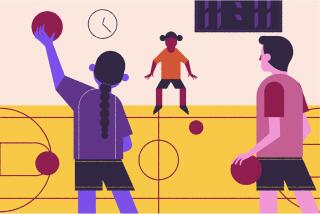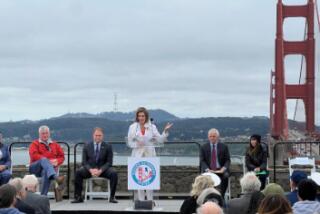U.S. Program Offers Gays a Safer Way to Socialize
- Share via
Sweating in shorts and tennis shoes, more than 35 men--and a handful of women--warmed up on the junior high school gymnasium floor. Then they divided themselves into six teams on three courts to play volleyball.
“It’s healthy,” Andy Reno, 22, a Long Beach nurse, said of the exercise. “It keeps people out of the bars.”
Which is the point. Welcome to Community Activities Network, the national Centers for Disease Control’s latest attempt to combat the AIDS epidemic.
Begun in Long Beach nearly a year ago, the program aims to offer homosexuals positive recreational activities as alternatives to risky sexual behavior.
“As far as we know, it’s unique in the country,” said David Martin, a clinical psychologist on the faculty of UCLA Medical School who serves as the program’s director. “I’m pleased with what’s happening.”
What’s happening, he says, is simple. At least two recent studies indicate that homosexual men with low self-esteem are more likely than others to engage in sexual activities that put them at high risk for contracting AIDS.
One study, conducted in San Francisco, showed a correlation between low levels of social support and high levels of risk. Another, conducted at the University of Oslo, found that men who engage in high-risk sex also tend to have fewer friends, be lonelier, drink more alcohol and have fewer, shorter and less-structured relationships.
“The fewer friends you have,” program coordinator Bill Geiger said, summarizing the findings, “the fewer available options you have, the less social networking you do and the more likely you are to hang out in bars, drink alcohol and engage in unsafe sex.”
Armed with a proposal by Martin, the CDC decided to attack the problem by allocating $110,000 to the Long Beach program the first year for administration and evaluation; it has just followed up with a promise of $130,000 for the second year.
Pilot Program
Organized under the auspices of The Center, a gay and lesbian community center in Long Beach where most of the activities are based, the project is seen as a pilot that organizers hope will be emulated elsewhere if successful.
It began with a Valentine’s Day dance earlier this year that attracted 200 people. Since then, Geiger says, the program has expanded to include an average of 950 participants attending as many as 15 events each month.
Among them: theater parties, concerts, shopping excursions, field trips, lectures, tapings and classes in Italian gourmet cooking, Spanish, and creative gift wrapping. Besides twice-weekly volleyball, the program sponsors a bicycling club, a flag football team, a bowling league and a scuba club.
Distributing Questionnaires
Martin says he’s tracking program efforts by distributing questionnaires to participants, asking them, among other things, to describe their sexual attitudes and practices.
By following up at six-month intervals, he hopes to gauge whether they are decreasing high-risk activities over time. He also hopes to compare their risk levels to those of outside control groups, including randomly selected patrons of gay bars.
Although solid results will not be available until next year, Martin responds to skeptics who consider the program frivolous by stressing the positive contribution he believes it has already made to homosexual life styles and the community in general.
“It’s in keeping with my sense of what needs to happen,” he said. “It provides a broader-based mechanism for developing community ties.”
A Positive Atmosphere
Indeed, many participants say the activities afford them a positive, nonsexual atmosphere in which to make friends with others who have similar interests. But not everyone at the recent volleyball game saw the event as particularly relevant to the fight against AIDS.
Roger Shagan, 40, a Long Beach delivery man for a meat company, said he participates in the games regularly, mainly as an alternative to watching television. “You need something to break the old cycle of boredom after work,” he said.
Jim Medina, 32, of Torrance, describing himself as “old-fashioned” and therefore sexually safe, said that playing volleyball was unlikely to change his life style in any appreciable way.
And Huntington Beach resident Pam Coopersmith, 29, one of the few women present, had a reason all her own for attending: “It’s a great way to interact with guys and not have to worry about them hitting up on you,” she said.
More to Read
Sign up for Essential California
The most important California stories and recommendations in your inbox every morning.
You may occasionally receive promotional content from the Los Angeles Times.









